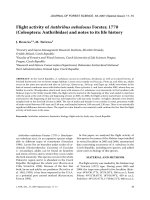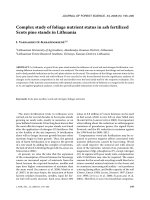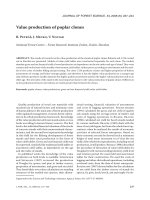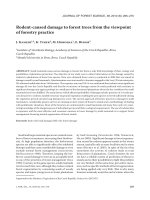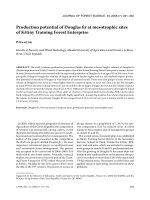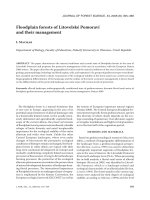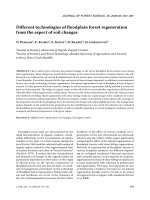Báo cáo lâm nghiệp: "Water relations of oak species growing in the natural 2 CO spring of Rapolano (central Italy) " potx
Bạn đang xem bản rút gọn của tài liệu. Xem và tải ngay bản đầy đủ của tài liệu tại đây (606.22 KB, 11 trang )
Original
article
Water
relations
of
oak
species
growing
in
the
natural
CO
2
spring
of
Rapolano
(central
Italy)
R
Tognetti
A Giovannelli
A
Longobucco
F
Miglietta
A
Raschi
1
Ce
SIA,
Accademia
dei
Georgofili,
Logge
degli
Uffizi
Corti,
50122;
2
IMGPF,
Consiglio
Nazionale
delle
Ricerche,
Via
Atto
Vannucci
13,
50134;
3
IATA,
Consiglio
Nazionale
delle
Ricerche,
Piazzale
delle
Cascine
18,
50144
Florence,
Italy
(Received
2
January
1995;
accepted
3
October
1995)
Summary —
The
effect
of
elevated
atmospheric
carbon
dioxide
on
water
relations
was
examined
on
downy
oak
(Quercus
pubescens)
and
holm
oak
(Q
ilex)
trees.
The
study
was
conducted
on
trees
growing
in
a
naturally
enriched
CO
2
spring.
Sap
velocity
and
sap
flow
were
measured
by
the
heat
pulse
technique.
On
the
same
trees,
daily
courses
of
xylem
water
potential,
leaf
conductance
and
transpiration
were
monitored.
Plant
water
relations
were
evaluated
by
pressure-volume
analysis
method
on
shoots;
on
the
same
branches,
relative
conductivity
of
xylem
was
measured.
Both
species
exhibited
increased
osmotic
potential
and
decreased
symplasmic
fraction
of
water
in
trees
adapted
to
increased
CO
2.
Downy
oak
showed
lower
stomatal
conductance
under
elevated
CO
2,
but
holm
oak
did
not.
Both
species
displayed
higher
sap
flow
in
control
trees.
In
both
species,
increased
carbon
dioxide
did
not
influence
xylem
embolism
formation.
drought / elevated
CO
2
/ embolism
/ Quercus
ilex
/ Ouercus pubescens
/
sap
flow
/ water
rela-
tions
Résumé —
Relations
hydriques
de
deux
espèces
de
chênes
poussant
près
d’une
source
enri-
chie
en
CO
2.
L’effet
de
l’enrichissement
de
l’atmosphère
en
CO
2
sur
les
relations
hydriques
du
Quer-
cus
pubescens
et
du
Q
ilex
a
été
étudié.
Les
mesures
ont
été
réalisées
au
cours
de
l’état,
sur
des
arbres
poussant
près
d’une
source
enrichie
naturellement
en
CO
2.
Les
flux
de
sève
brute
ont
été
mesurés
par
la
technique
de
l’impulsion
de
chaleur ;
sur les
mêmes
arbres,
les
cinétiques
journalières
de
potentiel
hydrique
foliaire,
de
conductance
foliaire
et
de
transpiration
ont
été
suivies.
Les
relations
hydriques
des
plantes
ont
été
évaluées
par
l’analyse
de
courbes
pression-volume
sur
les
bourgeons
des
mêmes
branches
prélevées
pour
les
mesures
de
conductivité
hydraulique
du
xylème.
Les
arbres
des
deux
espèces
ont
présenté
une
augmentation
du
potentiel
osmotique
et
une
diminution
de
la
fraction
d’eau
*
Correspondence
and
reprints
symplasmique
dans
le
milieu
à
plus
forte
concentration
en
CO
2
que
dans
le
milieu
ambiant.
Au
cours
des
deux journées
de
mesures,
au
contraine
de
Q
ilex,
Q
pubescens
a
présenté
une
conductance
sto-
matique
plus
faible
en
forte
concentration
en
CO
2
que
dans
un
milieu
ambiant.
Dans
les
deux
espèces
le
flux
de
sève
brute
des
arbres
témoins
était plus
élevé.
L’augmentation
de
la
concentration
de
CO
2
n’a
pas
influencé
la
formation
d’embolie
dans
les
deux
espèces.
embolie
/ enrichissement
en
CO
2
/ flux
de
sève
brute
/Quercus
ilex
/Quercus
pubescens
/
relations
hydriques
/ sécheresse
INTRODUCTION
Due
to
the
expected
climate
change
it
is
likely
that
water
stress
conditions
will
occur
more
frequently
in
the
next
decades.
This
will
interact
with
the
effects
that
increasing
global
levels
of
atmospheric
CO
2
will
have
on
the
anatomy
and
the
physiology
of
plants.
Most
studies
of
these
interactions
have
focused
on
gas
exchange
because
of
the
direct
relations
between
atmospheric
car-
bon
dioxide
concentrations
and
rate
of
assimilation
by
the
leaf
(Eamus
and
Jarvis,
1989).
It
has
been
shown
that
osmotic
adjust-
ment
(lower
solute
potential)
in
leaves
of
plants
exposed
to
elevated
CO
2
allows
them
to
maintain
higher
relative
water
content
and
turgor
pressure
(Morse
et
al,
1993).
By
maintaining
positive
turgor
pressure
and
hydraulic
efficiency,
plants
are
able
to
sus-
tain
growth
and
metabolism
during
drought.
High
concentration
of
atmospheric
carbon
dioxide
has
been
found
to
improve
the
response
to
water
stress
in
most
plants
by
inducing
stomatal
closure.
This
decreases
transpiration
and
increases
water-use
efi-
ciency
(WUE)
(Jarvis,
1989;
Eamus,
1991).
Elevated
carbon
dioxide
may,
in
addition,
induce
changes
in
hydraulic
architecture,
thus
possibly
influencing
the
vulnerability
to
cavitation
in
the
xylem
(Tyree
and
Alexan-
der,
1993).
However,
no
studies
have
yet
described
water
relations
of
adult
trees
sub-
jected
to
elevated
CO
2
over
their
entire
life
span.
It
has
been
recently
demonstrated
(Migli-
etta
and
Raschi,
1993)
that
sites
enriched
naturally
with
CO
2
(termed
CO
2
springs)
may
provide
the
opportunity
for
studying
adult
trees
exposed
throughout
their
devel-
opment
to
an
enriched
carbon
dioxide
atmo-
sphere.
Several
Mediterranean
tree
species
growing
in
the
Bossoleto
CO
2
spring
near
Rapolano
Terme
(central
Italy)
(van
Gardin-
gen
et
al,
1995)
offer
the
opportunity
to
bet-
ter
investigate
the
long-term
response
to
concurrent
CO
2
increase
and
water
stress,
as
well
as
to
compare
the
different
species
in
their
drought
tolerance.
The
great
real-
ism
of
experiments
carried
out
on
plants
in
natural
CO
2
springs
compared
to
labora-
tory
studies
and/or
manipulative
experiments
contributes
to
enhance
the
predictive
value
of
observations
made
at
these
sites
despite
the
lack
of
an
exact
control.
This
study
was
undertaken
with
the
aim
of
examining
water
relations
of
mature
trees
of
holm
oak
and
downy
oak
grown
in
ele-
vated
atmospheric
carbon
dioxide
during
a
drought
period
in
Mediterranean
conditions.
Trees
sampled
in
this
experiment
have
been
exposed
for
generations
to
elevated
CO
2
and
have
been
subjected,
during
this
time,
to
a
large
range
of
natural
disturbances.
MATERIALS
AND
METHODS
Plant
material
and
field
site
The
study
took
place
in
the
natural
CO
2
spring
of
Bossoleto,
located
near
Rapolano
Terme
(Siena,
central
Italy);
the
site
has
been
described
elsewhere
(Miglietta
et
al,
1993;
van
Gardingen
et
al,
1995).
The
CO
2
vents
occur
both
at
the
bottom
and
on
the
flanks
of
a
circular
doline;
concentra-
tion
gradients
are
enhanced
under
stable
(wind-
less)
atmospheric
conditions.
The
CO
2
concen-
trations
around
the
crown
of
the
plants
on
which
the
experiment
was
performed
ranged
in
daytime
hours from
500
to
1
000
ppm
with
rapid
fluctua-
tions.
The
H2S
concentration
in
the
spring
is
very
low
and
cannot
be
considered
harmful
to
plants
(Polle,
personal
communication).
The
control
site,
4
km
from
the
gas
vent,
was
chosen
as
being
characterized
by
similar
aspect,
light
exposure
and
vegetation.
Measurements
were
conducted
on
trees
of
downy
oak
(Quercus
pubescens
Wild)
and
holm
oak
(Quercus
ilex
L),
about
10
and
20
cm
in
diameter,
and
4
and
7
m
in
height,
respectively,
on
8
June
and
15
July
1993.
Shoot-water
relations
and
embolism
Daily
courses
of
xylem
water
potential
(Ψ),
leaf
conductance
(g
l)
and
transpiration
(E)
were
mea-
sured
at
2
hour
intervals
from
predawn
to
sun-
set,
using
a
pressure
chamber
(PMS
100,
PMS
Instrument
Co,
Corvallis,
OR,
USA)
and
a
null-
balance
steady-state
porometer
(LI-1600,Li-Cor
Inc,
Lincoln,
NE,
USA),
respectively.
Six
leaves
per
treatment
and
per
species
at
a
time,
collected
in
the
illuminated
part
of
the
crown,
were
sam-
pled
on
six
trees
of
the
same
dimension
selected
for
the
experiment
both
in
the
CO
2
spring
and
in
the
control
site.
In
July
(just
before
the
second
day
of
mea-
surements),
the
amount
of
xylem
embolism
was
evaluated
on
ten
terminal
branch
segments
(sim-
ilar
in
age
and
size)
from
the
upper
part
of
the
crown
for
each
treatment.
Branches
were
col-
lected
early
in
the
morning
and
placed
in
a
sealed
plastic
container.
In
the
laboratory,
branches
were
recut
under
water.
Hydraulic
conductivity
was
measured
on
stem
segments
about
15
cm
long,
using
the
technique
described
by
Sperry
et
al
(1988).
Distilled
water
was
acidified
(pH
1.8)
by
using
oxalic
acid
(10
mol
m
-3
)
and
degassed
by
agitating
it
under
vacuum
for
45-60
min.
This
solution
was
stored
in
an
air-free
plastic
bladder
enclosed
in
a
compressed
gas
tank.
The
perfus-
ing
solution
was
forced
through
the
samples
at
constant
low
pressure
(10
kPa),
passing
through
a
0.2
μm
in-line
filter.
The
flow
was
measured
with
an
analytical
balance
interfaced
with
a
com-
puter
to
automate
the
calculations.
The
initial
con-
ductivity
(k
i
),
calculated
from
the
flow-rate/pres-
sure-gradient
ratio,
was
recorded
every
30
s and
measured
by
averaging
ten
readings
after
steady
state
had
been
reached.
The
maximum
conduc-
tivity
(k
m)
was
calculated
as
previously
described
for
ki
by
repeating
the
measurements
after
flush-
ing
the
solution
through
the
stems
at
elevated
pressure
(180
kPa
for
60
min).
Embolism
was
expressed
as
the
percent
loss
of
hydrauiic
con-
ductivity
(LOSK
=
1100
(k
m
-k
i
)/k
m
).
Eight
shoots
per
tree,
from
the
branches
sam-
pled
for
conductivity
measurements,
were
selected
and
pressure-volume
curves
established
using
the
free
transpiration
method
(Hinckley
et
al,
1980).
Each
shoot
was
recut
in
distilled
water
and
rehydrated
overnight
in
a
dark
refrigerator.
During
the
next
day,
the
braches
were
left
to
dry
(tran-
spiring
freely)
on
the
laboratory
bench.
Fresh
weight
(measured
with
an
analytical
balance),
an
average
of
two
measurements
(one
before
and
one
following
the
measurements
of
water
poten-
tial)
and
water
potential
(measured
with
a
pressure
chamber)
were
recorded
at
regular
intervals
till
the
latter
achieved
about
-5
MPa.
Osmotic
poten-
tial
at
saturation
(π
sat
),
osmotic
potential
at
turgor
loss
point
(π
tlp
),
relative
water
content
at
turgor
loss
point
(RWC
tlp
)
and
symplastic
water
content
(Θ
sym
)
were
calculated
according
to
Schulte
and
Hinckley
(1985),
and
bulk
modulus
of
elasticity
(ϵ)
was
calculated
from
the
actual
data
pairs
as
(Δp/ΔRWC)RWC
where
Δp
is
the
change
in
turgor
pressure.
Many
pressure-volume
curves
showed
an
initial
plateau
near
full
turgor,
probably
due
to
overhydration
of
the
samples.
Plateaus
were
elim-
inated
and
appropriate
corrections
were
made
to
avoid
errors
in
the
parameters
derived
from
the
pressure-volume
curves
(Abrams
and
Menges,
1992).
Statistical
analyses
of
data
were
performed
using
analysis
of
variance
methods
followed
by
Duncan’s
multiple
range
test
with
P
< 0.05.
Sap
flux
Sap
velocity
and
sap
flow
were
measured
on
8-9
June
and
15-16
July
by
the
thermoelectric
’heat
pulse
method’
(HPV),
using
commercial
HPV
equipments
(Custom
HPV,
Division
of
Fruit
and
Trees,
DSIR,
Private
Bag,
Palmerson
North,
New
Zealand);
one
tree
for
control
and
one
for
spring
site
were
sampled
per
species.
The
basic
sensor
unit
consists
of
a
2-mm-
diameter
stainless
steel
heating
device
and
two
thermistor
probes
(1.8
mm
in
diameter),
situated
5
mm
below
and
10
mm
above
the
heating
device.
Four
heaters
were
vertically
installed
at
a
height
of
1
m
and
penetrated
the
xylem
to
a
maximum
depth
of
35
mm,
whereas
the
corresponding
ther-
mistor
pairs
were
inserted
at
a
depth
ranged
from
5
to
25
mm
beneath
the
cambium.
The
probes
and
heaters
were
connected
in
a
Wheatstone
bridge
configuration;
a
short
(1
s)
electrical
pulse
was
applied
to
the
heater.
The
heat
pulse
veloc-
ity
(recorded
at
30
min
intervals)
was
calculated
from
the
time
taken
by
the
re-equilibration
of
the
bridge,
ie,
by
the
heat
pulse
to
travel
the
distance
from
the
midpoint
of
the
two
probes
to
the
heat
(2.5
mm)
(Hüber
and
Schmidt,
1937);
the
con-
version
from
heat
velocity
to
sap
flow
was
made
according
to
Marshall’s
equation
(Marshall,
1958),
corrected
to
take
into
account
the
effect
of
sensor
implantation
wounds
(Swanson
and
Whitfield,
1981).
The
sapwood
components,
represented
by
the
volume
fraction
of
gas,
water
and
wood,
were
determined
on
increment
borings
by
Archimedes’s
principle
and
dry
weight.
The
area
of
sapwood
was
estimated
from
cores
passing
through
the
center
of
the
trunks.
RESULTS
Both
sampling
days
were
hot
and
sunny;
night
to
day
air
temperature
ranged
from
13-30
to
16-32
°C
(relative
humidity
ranged
from
40-50%
and
vapour
pressure
deficit
up
to
25
kPa),
respectively,
for
June
and
July.
No
rain
events
occurred
between
the
2
measurement
days.
Q
ilex
underwent
marked
water
stress.
Predawn
water
potential
from
-1
MPa
on
8
June
reached
-4
MPa
on
15
July
(fig
1
a
and
b);
on
both
days
minimum
potential
was
reached
at
about
midday.
On
both
mea-
surement
days,
differences
between
con-
trol
and
spring
site
were
not
significant.
On
8
June,
leaf
stomatal
conductance
and
tran-
spiration
reached
the
maximum
at
midday
(fig
1c);
no
midday
depression
was
evi-
denced
in
either
spring
and
control
plants.
Spring
trees
showed
a
tendency
for
lower
transpiration
(fig
1e),
although
the
differ-
ences
were
not
significant.
The
absolute
values
of g
l
and
Ewere
much
lower
in
July
(fig
1
d and
f),
and
daily
trends
were
much
less
evident.
Again,
no
significant
differ-
ences
existed
between
the
two
treatments.
Leaf
water
potential
in
Q pubescens
dis-
played
higher
absolute
values
than
Q
ilex
on
both
measurement
days
(fig
2a
and
b).
On
8
June,
predawn
values
were
about -0.3
MPa,
without
any
differences
between
spring
and
control
plants;
daily
minima
were
also
similar
in
both
treatments.
Yet,
during
the
day, spring
plants
showed
a
slower
decrease
of
the
values;
minima
of
about
-2.5
MPa
were
reached
at
about
1000
hours
in
control
plants
and
much
later
in
the
spring
plants.
Afternoon
recovery
was
quick
and
evident
in
both
treatments.
Leaf
conduc-
tance
and
transpiration
were
lower
in
spring
plants
(fig
2c
and
e).
Midday
depression
was
more
evident
in
control
plants.
On
15
July,
predawn
water
potential
was
lower
in
spring
trees
(fig
2b),
although
min-
ima
were
similar
for
both
treatments.
On
15
July, g
l
and
Ewere
much
lower
(fig
2d
and
f).
Morning
values
were
similar
in
both
treat-
ments,
while
in
the
afternoon
spring
trees
were
unable
to
recover.
Q
ilex
displayed
lower
values
than
Q
pubescens
for
Ψ, g
l
and
E in
both
June
and
July.
In
Q
ilex on
both
days
of
measurement,
sap
flow
and
velocity
started
to
rise
at
0530
hours,
reaching
the
maximum
values
in
the
early
hours
of
the
afternoon,
then
both
vari-
ably
decreased
to
the
night
base
line
(fig
3a
and
b).
The
spring
site
tree
showed
lower
absolute
values
than
control
trees.
Mea-
surements
taken
in
July
displayed
lower
sap
velocity
and
flow
than
those
in
June.
Q
pubescens
sap
flow
was
higher
in
June
and
in
the
control
(in
this
case
the
dif-
ference
was
less
evident
than
in
holm
oak)
tree
(fig
4a
and
b).
In
June,
sap
velocity
started
to
rise
earlier
in
the
control
tree
(at
0530
hours).
On
both
days
of
measurement,
maximum
sap
flow
was
reached
in
the
early
afternoon,
then
it
started
decreasing
until
the
night
base
line.
The
higher
absolute
val-
ues
recorded
in
Q
ilex are
probably
related
to
differences
in
crown
architecture
of
the
two
species.
LOSK
and
parameters
of
shoot-water
relations
(π
sat
,
π
tlp
,
RWCtlp
,
Θ
sym
and
ϵ)
are
presented
in
table
I.
LOSK
was
generally
high:
70
and
65%
in
spring
and
55
and
68%
in
control
holm
and
downy
oaks,
respec-
tively,
without
significant
differences
between
sites
and
species.
In
both
species,
values
of
π
sat
,
π
tlp
,
RWCtlp
and
Θ
sym
were
signifi-
cantly
lower
in
spring
plants,
while
there
were
no
site
differences
in
ϵ.
Under
high
CO
2,
trees
showed
a
decrease
in
osmotic
potential
of
0.3-0.4
MPa
and
an
increase
(although
statistically
not
significant)
in
the
bulk
modulus
of
elasticity
at
full
hydration
of
1-1.5
MPa.
Q
ilex
showed
significantly
higher
absolute
values
of
π
sat
,
π
tlp
,
RWCtlp
and
Θ
sym
than
Q
pubescens
in
both
treat-
ments.
DISCUSSION
Previous
research
in
growth
chambers
has
demonstrated
that
an
increase
in
CO
2
may
cause
a
reduction
of
stomatal
density,
but
prolonged
exposure
to
elevated
CO
2
may
have
a
different
effect
on
different
species
(Woodward
and
Bazzaz,
1988;
Idso,
1989).
research
in
natural
CO
2
spring
did
show
some
differences
in
stomatal
density
and
dimension
(Miglietta
and
Raschi,
1993;
Paoletti,
personal
communication);
how-
ever,
the
high
variability
and
the
presence
of
other
environmental
effects
make
it
difficult
to
draw
any
conclusions.
Most
studies
have
shown
that
increased
ambient
carbon
diox-
ide
brings
about
a
decrease
in
stomatal
con-
ductance
(Eamus
and
Jarvis,
1989).
On
the
other
hand,
stomatal
sensitivity
to
increasing
CO
2
varies
with
species
and
the
effect
is
mediated
by
intercellular
space
CO
2
con-
centration
rather
than
by
ambient
CO
2
con-
centration
(Mott,
1988),
and
depends
upon
the
degree
of
coupling
between
the
leaf
and
the
atmosphere
above
the
leaf
surface.
Holm
oak
trees
growing
in
the
carbon
dioxide
spring
did
not
show
significant
dif-
ferences
in
leaf
conductance
and
transpi-
ration
with
respect
to
the
control
trees.
For
the
second
day
of
measurements
(in
July),
this
may
be
attributed
to
the
relative
insen-
sitivity
of
stomata
to
CO
2
concentration
under
severe
drought;
water
stress
condi-
tions
at
the
beginning
of
June,
the
first
day
of
measurements,
had
not
yet
developed.
In
contrast,
downy
oak
trees
grown
under
high
CO
2
displayed
lower
leaf
conductance
and
transpiration
than
control
trees
on
both
measurement
days.
The
differences
(par-
ticularly
in
July)
were
exacerbated
in
the
afternoon
at
higher
vapour
pressure
deficit
(Oechel
and
Strain,
1985).
Leaf
conduc-
tance
and
transpiration
in
downy
oak
showed
a
midday
depression
which
was
more
evident
in
control
trees
and
in
June.
At
the
same
time,
values
of
leaf
water
potential
were
higher
in
spring
trees
for
a
great
part
of
the
day.
In
this
sense,
a
beneficial
effect
of
elevated
CO
2
on
water
relations
was
evi-
dent.
This
effect
was
not
seen
in
holm
oak;
as
water
stress
developed,
daily
water
potential
did
not
differ
greatly
between
the
two
treatments,
obscuring
the
importance
of
this
parameter
as
an
aspect
of
drought
tolerance
in
oaks
under
elevated
CO
2
(Tyree
and Alexander,
1993).
In
spite
of
being
considered
as
more
suit-
able
for
diffuse
porous
tree
species,
as
it
assumes
wood
is
essentially
homogeneous,
the
HPV
technique
has
been
applied
suc-
cessfully
to
ring-porous
tree
species
(Miller
et
al,
1980;
Borghetti
et
al,
1993;
Raschi
et
al,
1995).
In
this
experiment,
despite
lim-
ited
dimension
of
the
sample,
sap
velocity
and
sap
flow
values
were
consistent
with
stomatal
behaviour.
Spring
trees
showed
a
lower
sap
velocity
and
sap
flow,
but
the
dif-
ference
was
much
more
evident
in
downy
oak,
rather
than
in
holm
oak.
The
July
values
were
much
lower
than
the
June
values.
The
absolute
values
were
consistent
with
those
reported
by
other
authors
using
the
same
technique
(Visser
et
al,
1989;
Borghetti
et
al,
1993).
The
peaks
of
sap
flow
from
the
night
baseline
may
depend
on
nocturnal
transpiration,
common
in
Mediterranean
environment,
and/or
on
re-allocation
of
water
in
different
parts
of
the
plant
subjected
to
water
potential
gradient.
The
phenomenon
disappeared
in
July,
under
greater
water-
stress
conditions.
The
differences
in
sap
flow
and
sap
velocity
between
the
two
species
were
consistent
with
the
differences
in
the
size
of
trees.
Estimated
values
of
π
sat
,
π
tlp
,
RWCtlp
,
Θ
sym
and
ϵ
were
similar
to
those
found
in
the
same
oak
species
by
other
authors
(Salleo
and
Lo
Gullo,
1990;
Dreyer
et
al,
1992;
Sala
and
Tenhunen,
1994).
The
observed
shift
in
osmotic
potential
(both
at
full
turgor
and
zero
turgor)
in
response
to
CO
2
in
both
species
may
enable
plants
to
withstand
lower
water
potentials
(Morse
et
al,
1993).
Osmotic
adjustment
in
leaves
of
spring
trees
may
contribute
to
maintain
higher
RWC
and
turgor
pressure,
then
pre-
venting
full
stomatal
closure
and
allowing
net
photosynthesis
to
proceed
during
severe
drought.
In
other
experiments
(Johnson
et
al,
1996;
Johnson,
Tognetti
and
Michelozzi,
unpublished
data),
downy
oak
and
holm
oak
growing
in
the
CO
2
spring
showed
increased
production
of
secondary
compounds
(tan-
nins)
and
total
nonstructural
carbohydrates;
this
may
provide
an
available
source
of
osmoticum
(Abrams,
1990).
Despite
the
absence
of
significant
differences
in
elas-
tic
modulus between
treatments,
the
ten-
dency
to
have
higher
tissue
inelasticity
may
help
trees
in
the
CO
2
spring,
particularly
downy
oak,
to
generate
a
favourable
water
potential
gradient
from
the
soil
to
the
plant,
at
lower stomatal
conductances.
The
decrease
in
symplasmic
fraction of
water,
and
the
relative
increase
in
apoplasmic
frac-
tion,
found
for
the
spring
trees,
could
reflect
an
increase
in
xylem
volume,
a
possible
feature
associated
with
growth
in
elevated
CO
2
(Tyree
and
Jarvis,
1982).
Q
ilex
showed
greater
absolute
values
of
π
sat
,
π
tlp
,
RWCtlP
and
Θ
sym
than
Q pubescens
in
both
spring
and
control
site.
Such
species
dif-
ferences
are
consistent
with
the
leaf
con-
ductance
and
sap
flow
data,
and
may
be
related
to
the
ability
of
Q
ilex
to
tolerate
lower
water
potentials.
The
possibility
that
the
turgor
response
in
Q
ilex
overrode
the
CO
2
effect
cannot
be
ruled
out.
In
Q
pubescens,
despite
the
osmotic
adjustment
showed
by
spring
trees,
leaf
conductance
was
lower
than
control
trees.
Despite
big
differences
in
vulnerability
to
xylem
embolism
(Raschi
and
Tognetti,
unpublished
data)
and
in
xylem
anatomy
(holm
oak
being
a
diffuse-porous
tree
with
vessels
up
to
150
μm
in
diameter
and
downy
oak
a
ring-porous
tree
with
vessels
up
to
500
μm
in
diameter),
both
species
reached
approximately
the
same
levels
of
LOSK
in
branches:
over
60%.
The
threshold-type
relationship
existing
between
decreasing
water
potential
and
embolism
formation,
and
the
very
low
leaf
water
potential
reached
at
midday
by
both
holm
and
downy
oak
in
our
experiment
(over
the
value
necessary
to
cause
60%
of
LOSK),
could
explain
this
similarity.
However,
holm
oak
spring
trees
showed
a
tendency
for
higher
LOSK
than
control
trees,
while
downy
oak
exhibited
an
opposite
trend
with
may
be
attributed
to
stomatal
regulation
being
more
sensitive
to
high
CO
2.
Embolism
formation
may
be
par-
tially
responsible
for
the
observed
general
decrease
of
sap
flow
in
July;
leaf
water
potentials
reached
levels
for
which
cavitation
rates
can
significantly
increase.
In
conclusion,
elevated
carbon
dioxide
can
ameliorate
the
effects
of
drought
on
these
two
oak
species
by
increasing
osmotic
potential
and
apoplasmic
fraction
of
water.
From
this
study,
increased
carbon
dioxide
does
not
show
a
clear
influence
on
cavitation
and
embolism
formation.
Down
oak
exhib-
ited
lower
stomatal
conductance
in
spring
tree,
probably
increasing
WUE
and
enhanc-
ing
the
possibility
to
compete
successfully
in
high
CO
2
environment
during
dry
periods.
In
another
study,
downy
oak
displayed
simi-
lar
performances
in
both
mature
trees
and
seedlings
by
increasing
WUE
and
by
fixing
increased
amount
of
carbon;
this
resulted
in
higher
foliar
tannin
concentrations,
increased
specific
leaf
weight
and
enhanced
isoprene
emission
(Johnson
et
al,
1996).
Further
studies
on
trees
growing
in
the
spring
are
needed
to
better
understand
species
differences
and
the
relative
contri-
butions
of
physiological,
morphological
and
biochemical
mechanims
in
adaption
to
high
CO
2
and
drought.
ACKNOWLEGMENTS
This
work
has
been
supported
by
EV
Programme
Environment.
Contract
EV5V
CT
92-0093.
REFERENCES
Abrams
MD
(1990)
Adaptions
and
responses
to
drought
in
Quercus
species
of
North
America.
Tree
Physiol 7,
227-238
Abrams
MD,
Menges
ES
(1992)
Leaf
ageing
and
plateau
effects
on
seasonal
pressure-volume
relationships
in
three
sclerophyllous
Quercus
species
in
South-
eastern
USA.
Funct
Ecol6,
353-360
Borghetti
M,
Raschi
A,
Grace
J
(1989)
Ultrasound
emis-
sion
after
cycles
of
water
stress
in
Picea
abies.
Tree
Physiol 5,
229-237
Borghetti
M,
De
Angelis
P,
Raschi
A,
Scarascia
Mug-
nozza
GE,
Tognetti
R,
Valentini
R
(1993)
Relations
between
sap
velocity
and
cavitation
in
broad
leaved
trees.
In:
Water
Transport
in
Plants
under
Climatic
Stress
(M
Borghetti,
J
Grace,
A
Raschi,
eds),
Cam-
bridge
University
Press,
Cambridge,
UK,
114-128
Dreyer
E,
Epron
D,
Yog
Matig
OE
(1992)
Photochemical
efficiency
of
photosystem
II
in
rapidly
dehydrating
leaves
of
11
temperate
and
tropical
tree
species
dif-
fering
in
their
tolerance
to
drought.
Ann
Sci
For 49,
615-625
Eamus
D
(1991)
The
interaction
of
rising
CO
2
and
tem-
peratures
with
water
use
efficiency.
Plant
Cell
Env-
iron
14,
843-852
Eamus
D,
Jarvis
PG
(1989)
The
direct
effects
of
increase
in
the
global
atmospheric
CO
2
concentration
on
nat-
ural
and
commercial
temperate
trees
and
forests.
Adv
Ecol
Res
19,
1-55
Hinckley
TM,
Duhme
F,
Hinckley
AR,
Richter
H
(1980)
Water
relations
of
drought
hardy
shrubs:
osmotic
potential
and
stomata
reactivity.
Plant
Cell
Environ
3,
131-140
Hüber
B,
Schmidt
E
(1937)
Eine
Kompensationmeth-
ode
zur
thermoelektrischen
Messung
langsamer
Luftstrom.
Ber
Deut
Bot
Ges
55,
514-529
lolso
SB
(1989)
Carbon
dioxide
and
global
change:
earth
in
transition.
IBR
Press,
Tempe,
AZ,
USA
Jarvis
PG
(1989)
Atmospheric
carbon
dioxide
and
forests.
Philos
Trans
R
Soc
Lond
(Biol]
324,
369-
392
Johnson
JD,
Michelozzi
M,
Tognetti
R
(1996)
Carbon
physiology
of
Quercus
pubescens
growing
at
the
Bossoleto
CO
2
spring
in
Central
Italy.
In:
Carbon
Dioxide
Springs
and
their
Use
in
Biological
Research
(A
Raschi,
F
Miglietta,
P Van
Gardingen,
eds),
Cam-
bridge
University
Press,
Cambridge,
UK
(in
press)
Marshall
DC
(1958)
Measurement
of
sap
flow
in
conifers
by
heat
transport.
Plant Physiol 33,
385-396
Miglietta
F,
Rashi
A
(1993)
Studying
the
effect
of
ele-
vated
CO
2
in
the
open
in
a
naturally
enriched
envi-
ronment
in
central
Italy.
Vegetatio
104/105,
391-402
Miglietta
F,
Raschi
A,
Bettarini
I,
Resti
R,
Selvi
F
(1993)
Natural
CO
2
springs
in
Italy:
a
resource
for
examin-
ing
long-term
response
of
vegetation
to
rising
atmo-
spheric
CO
2
concentrations.
Plant
Cell
Environ
16,
873-878
Miller
DR,
Vavrina
CA,
Christensen
TW
(1980)
Mea-
surement
of
sap
flow
and
transpiration
in
ring-porous
oaks
using
a
heat
pulse
velocity
technique.
For Sci
26, 485-489
Morse
SR,
Wayne
P,
Miao
SL,
Bazzaz
FA
(1993)
Ele-
vated
CO
2
and
drought
after
tissue
water
relations
of
birch
(Betula
populifolia
Marsh)
seedlings.
Oecologia
95, 599-602
Mott
KA
(1988)
Do
stomata
respond
to
CO
2
concentra-
tion
other
than
intercellular?
Plant
Physiol 86,
200-
203
Oechel
WC,
Strain
BR
(1985)
Native
species
responses
to
increased
atmospheric
carbon
dioxide
concen-
tration.
In:
Direct Effects
of Increasing
CO
2
on
Veg-
etation
(BR
Strain,
JD
Cure,
eds),
United
States
Dept
of
Energy,
DOE/ER-0238,
117-154
Raschi
A,
Tognetti
R,
Ridder
HW,
Beres
C
(1995)
Water
in
the
stems
of
sessile
oak
(Quercus
petraea)
assessed
by
computer
tomography
with
concurrent
measurements
of
sap
velocity
and
ultrasound
emi-
sion.
Plant
Cell
Environ
18,
545-554
Sala
A,
Tenhunen
JD
(1994)
Site-specific
water
rela-
tions
and
stomatal
response
of
Quercus
ilex
in
a
Mediterranean
watershed.
Tree
Physiol 14,
601-617
Salleo
S,
Lo
Gullo
MA
(1990)
Sclerophylly
and
plant
water
relations
in
three
Mediterranean
Quercus
species.
Ann
Bot
65,
259-270
Schulte
PJ,
Hinckley
TM
(1985)
A
comparison
of
pres-
sure-volume
curve
data
analysis
techniques.
J
Exp
Bot 36,
1590-1602
Sperry
JS,
Donnelly
R,
Tyree
MT
(1988)
A
method
for
measuring
hydraulic conductivity
and
embolism
in
xylem.
Plant
Cell
Environ
11,
35-40
Swanson
RH,
Whitfield
DWA
(1981)
A
numerical
anal-
ysis
of
heat
pulse
velocity:
theory
and
practice.
J
Exp
Bot 32, 221-239
Tyree
MT,
Jarvis
PG
(1982)
Water
in
tissues
and
cells.
In:
Encyclopedia
of
Plant
Physiology (OL
Lange,
PS
Nobel,
CB
Osmond,
H
Ziegler,
eds),
Springer-Verlag,
Berlin,
vol
12C,
35-77
Tyree
MT,
Alexander
JD
(1993)
Plant
water
relations
and
the
effects
of
elevated
CO
2:
a
review
and
sug-
gestions
for
future
research.
Vegetatio
104/105, 47-
62
van
Gardingen
PR,
Grace
J,
Harkness
DD,
Miglietta
F,
Raschi
A
(1995)
Carbon
dioxide
emission
at
an
Ital-
ian
mineral
spring:
measurements
of
average
CO
2
concentration
and
air
temperature.
Agric For Mete-
orol73,
17-27
Visser
H,
Noppert
F,
van
Wakeren
H,
Vaessen
J
(1989)
Xylem
sap
velocity
in
relation
to
weather
and
air
pol-
lution.
IAWA
Bull 4,
427-439
Woodward
FI,
Bazzaz
FA
(1988)
The
responses
of
stom-
atal
density
to
CO
2
partial
pressure.
J
Exp
Bot
39,
1771-1781
